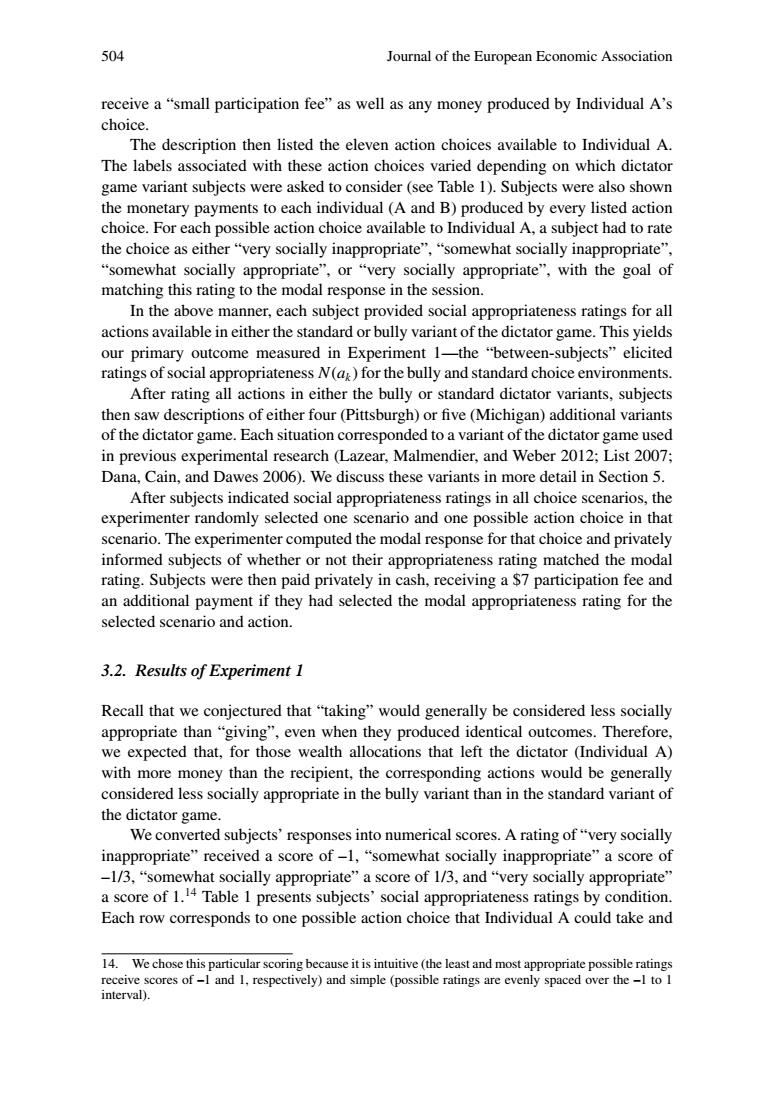正在加载图片...

504 Journal of the European Economic Association receive a"small participation fee"as well as any money produced by Individual A's The description then listed the eleven action choices available to Individual A. The labels associated with these action choices varied depending on which dictator game variant subjects were asked to consider(see Table 1).Subjects were also shown hoy paymens to each indv y evry lised acton ice.For ea possible bject had to ra the choice as either"very socially inappropriate""somewhat socially inappropriate" “somewhat socially appropriate”,or“very socially appropriate'”,with the goal of matching this rating to the modal response in the session. In the above manner.each subiect provided social appropriateness ratings for all actions available in either the standard or bully variant of the dictator g me.This vields our primary outcome measured abjects”elicite ratings of social appropriateness N()for the bully and standard choice environments After rating all actions in either the bully or standard dictator variants,subjects then saw descriptions of either four(Pittsburgh)or five (Michigan)additional variants of the dictator game.Each situation corresponded to a variant of the dictator game used mental Malmendier and Weber 2012:List 2007 Dana.Cain.and Dawes 2006).We discuss these variants in more detail in Section 5 After subjects indicated social appropriateness ratings in all choice scenarios,the experimenter randomly selected one scenario and one possible action choice in that scenario.The experimenter computed the modal response for that choice and privately ect s of whethe r no tthei modal rating Subjects were then paid privately in cash.rec an additional payment if they had selected the modal appropriateness rating for the selected scenario and action. 3.2.Results of Experiment 1 Recall that we conjectured that"taking"would generally be considered less socially n“giving",even when t hey produc cediden The or thah that eft the dictator dndivdunl cal with more money than the recipient,the corresponding actions would be generally considered less socially appropriate in the bully variant than in the standard variant of the dictator game We c verted subjectsresponses into numerical scores.Arating of "very socially appropriate "received a score of-1."somewhat socially inappropriate"a score o rtTblemy Each row corresponds to one possible action choice that Individual A could take and fencorcsof-l504 Journal of the European Economic Association receive a “small participation fee” as well as any money produced by Individual A’s choice. The description then listed the eleven action choices available to Individual A. The labels associated with these action choices varied depending on which dictator game variant subjects were asked to consider (see Table 1). Subjects were also shown the monetary payments to each individual (A and B) produced by every listed action choice. For each possible action choice available to Individual A, a subject had to rate the choice as either “very socially inappropriate”, “somewhat socially inappropriate”, “somewhat socially appropriate”, or “very socially appropriate”, with the goal of matching this rating to the modal response in the session. In the above manner, each subject provided social appropriateness ratings for all actions available in either the standard or bully variant of the dictator game. This yields our primary outcome measured in Experiment 1—the “between-subjects” elicited ratings of social appropriateness N(ak ) for the bully and standard choice environments. After rating all actions in either the bully or standard dictator variants, subjects then saw descriptions of either four (Pittsburgh) or five (Michigan) additional variants of the dictator game. Each situation corresponded to a variant of the dictator game used in previous experimental research (Lazear, Malmendier, and Weber 2012; List 2007; Dana, Cain, and Dawes 2006). We discuss these variants in more detail in Section 5. After subjects indicated social appropriateness ratings in all choice scenarios, the experimenter randomly selected one scenario and one possible action choice in that scenario. The experimenter computed the modal response for that choice and privately informed subjects of whether or not their appropriateness rating matched the modal rating. Subjects were then paid privately in cash, receiving a $7 participation fee and an additional payment if they had selected the modal appropriateness rating for the selected scenario and action. 3.2. Results of Experiment 1 Recall that we conjectured that “taking” would generally be considered less socially appropriate than “giving”, even when they produced identical outcomes. Therefore, we expected that, for those wealth allocations that left the dictator (Individual A) with more money than the recipient, the corresponding actions would be generally considered less socially appropriate in the bully variant than in the standard variant of the dictator game. We converted subjects’ responses into numerical scores. A rating of “very socially inappropriate” received a score of –1, “somewhat socially inappropriate” a score of –1/3, “somewhat socially appropriate” a score of 1/3, and “very socially appropriate” a score of 1.14 Table 1 presents subjects’ social appropriateness ratings by condition. Each row corresponds to one possible action choice that Individual A could take and 14. We chose this particular scoring because it is intuitive (the least and most appropriate possible ratings receive scores of –1 and 1, respectively) and simple (possible ratings are evenly spaced over the –1 to 1 interval)